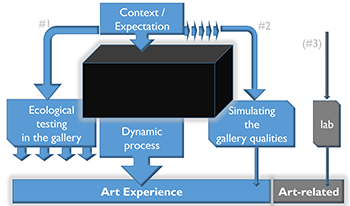References
1FitchW. T.Westphal-FitchG.2013Fechner revisited: towards an inclusive approach to aestheticsBehav. Brain Sci.36140141140–110.1017/S0140525X12001604
2CarbonC. C.2016Creating a framework for holistic assessment of aesthetics: A response to Nilsson and Axelsson (2015) on attributes of aesthetic quality of textile qualityPerceptual Motor Skills1229610096–10010.1177/0031512516628366
3MarkovicS.
4PelowskiM.AkibaF.2011A model of art perception, evaluation and emotion in transformative aesthetic experienceNew Ideas Psychology29809780–9710.1016/j.newideapsych.2010.04.001
5CarbonC. C.2011Cognitive mechanisms for explaining dynamics of aesthetic appreciationi-Perception2708719708–1910.1068/i0463aap
6ShimamuraA. P.Experiencing Art: In the Brain of the Beholder2013Oxford University PressNew York
7DeweyJ.Art as Experience1934Perigree BooksNew York
8HesslingerV. M.CarbonC. C.HechtH.2017Social factors in aesthetics: Social conformity pressure and a sense of being watched affect aesthetic judgmentsi-Perception81161–1610.1177/2041669517736322
9BoernerS.JobstJ.WiemannM.2010Exploring the theatrical experience: results from an empirical investigationPsychol. Aesthetics Creat. Arts4173180173–8010.1037/a0018460
10KleinJ.
11CarbonC. C.JakeschM.2013A model for haptic aesthetic processing and its implications for designProc. IEEE1011111–1110.1109/JPROC.2012.2219831
12LederH.BelkeB.OeberstA.AugustinD.
13BelkeB.LederH.CarbonC. C.2015When challenging art gets liked: Evidences for a dual preference formation process for fluent and non-fluent portraitsPloS ONE10e013179610.1371/journal.pone.0131796
14MuthC.RaabM. H.CarbonC. C.2015The stream of experience when watching artistic movies. Dynamic aesthetic effects revealed by the Continuous Evaluation Procedure (CEP)Frontiers Psychology610.3389/fpsyg.2015.00365
15MuthC.CarbonC. C.2013The Aesthetic Aha: On the pleasure of having insights into GestaltActa Psychologica144253025–3010.1016/j.actpsy.2013.05.001
16CarbonC. C.2017Art perception in the museum: How we spend time and space in art exhibitionsi-Perception81151–1510.1177/2041669517694184
17LocherP. J.OverbeekeK.WensveenS.
18ArmstrongT.Detweiler-BedellB.
19FeldmanE. B.Varieties of visual experience19924th ed.Prentice HallUpper Saddle River, NJ
20PelowskiM.2015Tears and transformation: feeling like crying as an indicator of insightful or “aesthetic” experience with artFrontiers Psychology6100610.3389/fpsyg.2015.01006
21PalmerS. E.SchlossK. B.SammartinoJ.2013Visual aesthetics and human preferenceAnnu. Rev. Psychol.647710777–10710.1146/annurev-psych-120710-100504
22SilviaP. J.
23VogtS.MagnussenS.
24CarbonC. C.FaerberS. J.GergerG.ForsterM.LederH.
25RediesC.GrossF.2013Frames as visual links between paintings and the museum environment: an analysis of statistical image propertiesFrontiers Psychol.410.3389/fpsyg.2013.00831
26ChenJ. C.LoL. Y.2016A statistical approach for photo quality assessmentJ. Internet Technology17124912571249–5710.6138/JIT.2016.17.6.20150603b
27LocherP. J.
28WagemansJ.WagemansJ.Historical and conceptual background: Gestalt theoryOxford Handbook of Perceptual Organization2015Oxford University PressOxford, UK
29WagemansJ.FeldmanJ.GepshteinS.KimchiR.PomerantzJ. R.van der HelmP. A.van LeeuwenC.2012A century of Gestalt Psychology in visual perception: II. Conceptual and theoretical foundationsPsychological Bulletin138121812521218–5210.1037/A0029334
30HaertelM.CarbonC. C.2014Is this a “Fettecke” or just a “greasy corner”? About the capability of laypersons to differentiate between art and non-art via object’s originalityi-Perception5602610602–1010.1068/i0664
31MakinA. D. J.
32ParsonsT. D.Clinical Neuropsychology and Technology2016SpringerHeidelberg
33MuthC.RaabM. H.CarbonC. C.
34MuthC.HesslingerV. M.CarbonC. C.2018Variants of semantic instability (SeIns) in the arts. A classification study based on experiential reportsPsychology Aesthetics, Creativity, Arts1210.1037/aca0000113
35BrieberD.LederH.NadalM.2015The experience of art in museums: An attempt to dissociate the role of physical context and genuinenessEmpirical Studies Arts339510595–10510.1177/0276237415570000
36GrafL. K. M.LandwehrJ. R.2015A dual-process perspective on fluency-based aesthetics: The pleasure-interest model of aesthetic likingPersonality Social Psychology Review19395410395–41010.1177/1088868315574978
37PelowskiM.MarkeyP. S.LauringJ. O.LederH.2016Visualizing the impact of art: An update and comparison of current psychological models of art experienceFrontiers Human Neuroscience1010.3389/fnhum.2016.00160
38BrieberD.NadalM.LederH.RosenbergR.2014Art in time and space: Context modulates the relation between art experience and viewing timePLoS ONE910.1371/journal.pone.0099019
39PelowskiM.ForsterM.TinioP. P. L.SchollM.LederH.2017Beyond the lab: An examination of key factors influencing interaction with ‘real’ and museum-based artPsychology Aesthetics Creativity Arts11245264245–6410.1037/aca0000141
40IkardC.
41SmithJ. K.SmithL. F.
42SmithL. F.SmithJ. K.TinioP. P. L.2017Time spent viewing art and reading labelsPsychology Aesthetics Creativity Arts11778577–8510.1037/aca0000049
43TröndleM.WintzerithS.WäspeR.TschacherW.2012A museum for the twenty-first century: the influence of ‘sociality’ on art reception in museum spaceMuseum Management Curatorship271261–2610.1080/09647775.2012.737615
44LocherP. J.SmithJ. K.SmithL. F.
45NyströmM.AnderssonR.HolmqvistK.van de WeijerJ.2013The influence of calibration method and eye physiology on eyetracking data qualityBehavior Research Methods45272288272–8810.3758/s13428-012-0247-4
46LocherP. J.DoleseM.“A comparison of the perceived pictorial and aesthetic qualities of original paintings and their postcard images,”Empirical Studies Arts 22, 129–142 (2004) 47WolzS.CarbonC. C.2014What’s wrong with an art fake? Cognitive and emotional variables influenced by authenticity status of artworksLeonardo47467473467–7310.1162/LEON_a_00869
48SilviaP. J.2009Looking past pleasure: Anger, confusion, disgust, pride, surprise, and other unusual aesthetic emotionsPsychology Aesthetics, Creativity, Arts3485148–5110.1037/A0014632
49AugustinM. D.WagemansJ.CarbonC. C.2012All is beautiful? Generality versus specificity of word usage in visual aestheticsActa Psychologica139187201187–20110.1016/j.actpsy.2011.10.004
50AugustinM. D.LederH.HutzlerF.CarbonC. C.2008Style follows content: On the microgenesis of art perceptionActa Psychologica128127138127–3810.1016/j.actpsy.2007.11.006
51WagemansJ.

 Find this author on Google Scholar
Find this author on Google Scholar Find this author on PubMed
Find this author on PubMed